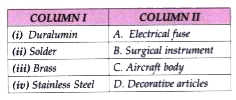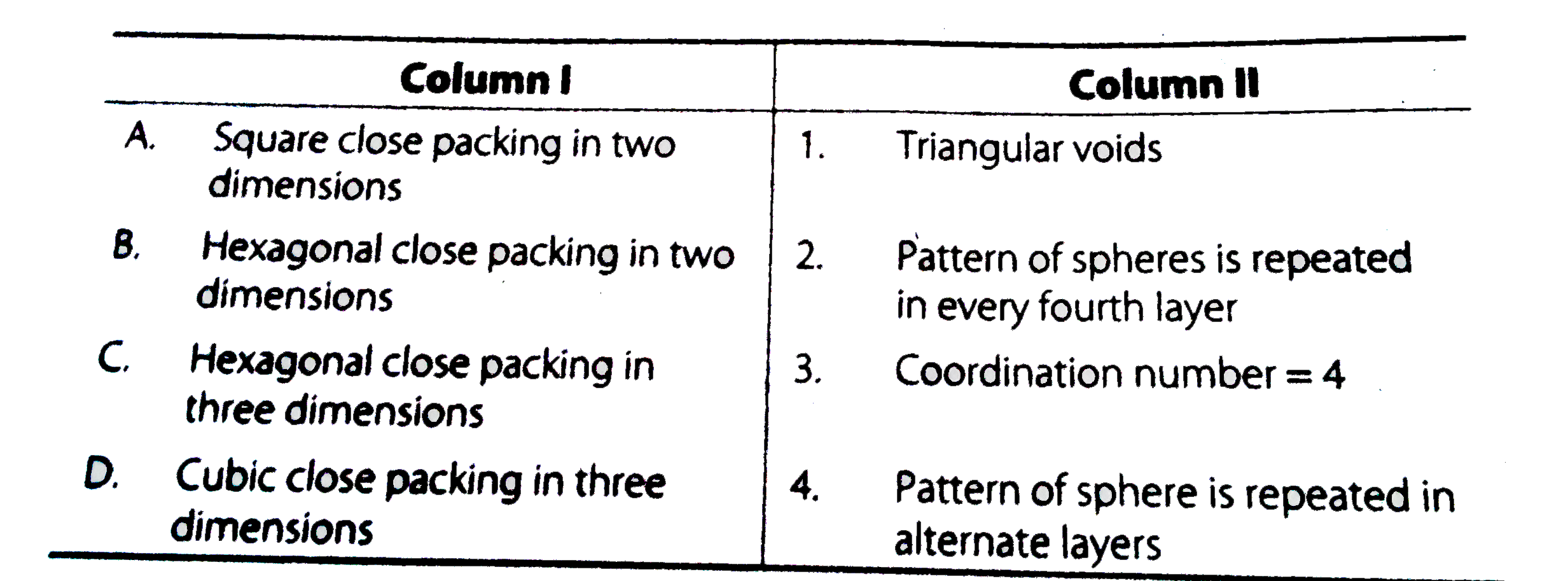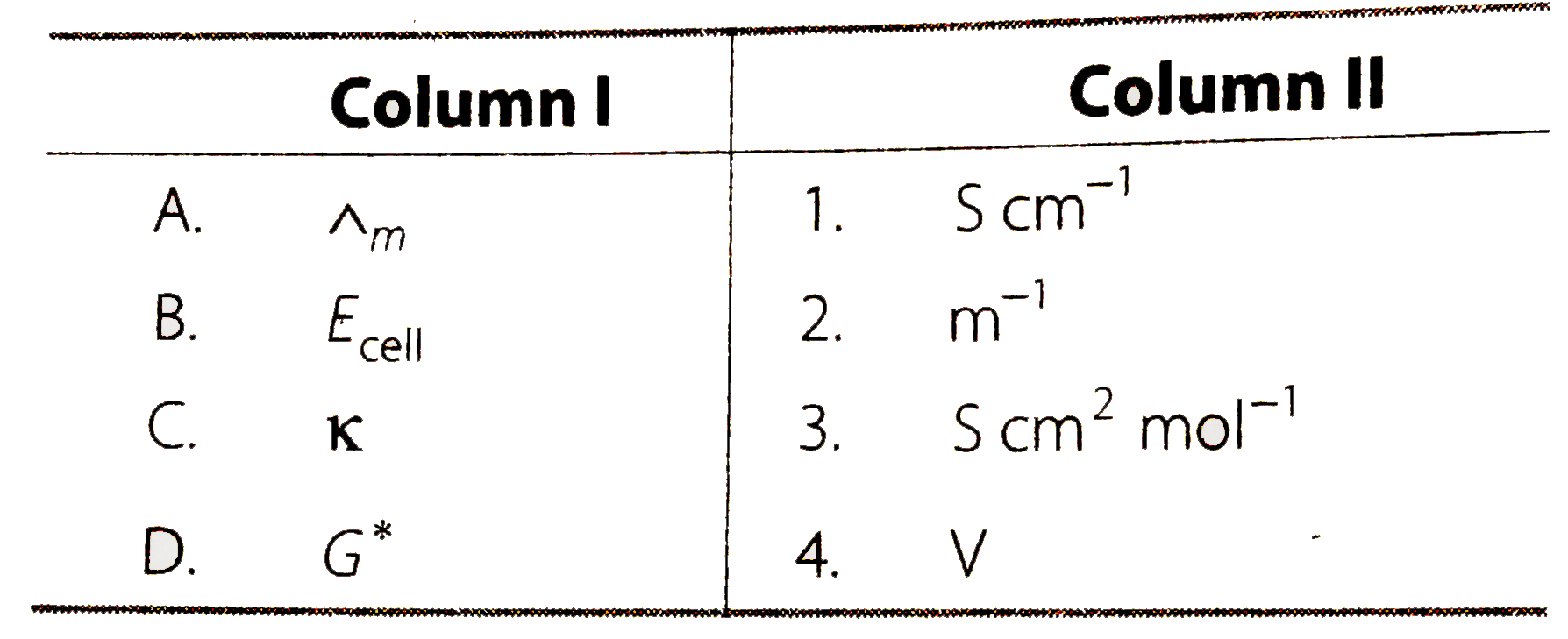ColumnI lists physical quantities for a uniform current carrying conductor . These quantities depend on quantities given in column II. Match entries in column I to all the quantities in column II on which it depends.
Column IColumn II(A)Resistivity(p)Length of conductor(B)Current through the conductor for a given potential difference across the condcutor(q)Electric field in conductor(C)Current density in condcutor for a given potential difference across the conductor (r)Temperature of conductor(D)Thermal power generated per unit volume for given value of potential difference across the conductor(s)Nature of conductor(t)Area of condcutor
The correct Answer is:A(r, s), B(p, r, s, t), C(p, q, r, s), D(p, q, r, s)
To solve the problem of matching the physical quantities in Column I with the corresponding quantities in Column II, we will analyze each entry in Column I and determine which entries in Column II they depend on.
1. Identify the dependencies for Resistivity (A):
- Resistivity (ρ) is a property of the material and depends on:
- Temperature (r): As temperature changes, the resistivity of a conductor changes.
- Nature of conductor (s): Different materials have different resistivities.
- Therefore, for A (Resistivity), the matches are (r) Temperature and (s) Nature of conductor.
2. Identify the dependencies for Current through the conductor for a given potential difference (B):
- According to Ohm's Law, I=VR and R=ρLA. Thus, current depends on:
- Length of conductor (p): As length increases, resistance increases, affecting current.
- Area of conductor (t): As area increases, resistance decreases, affecting current.
- Resistivity (r): Different materials (resistivity) will affect the current.
- Temperature (r): Since resistivity changes with temperature, it indirectly affects current.
- Therefore, for B (Current), the matches are (p) Length of conductor, (t) Area of conductor, (r) Temperature, and (s) Nature of conductor.
3. Identify the dependencies for Current density in conductor for a given potential difference (C):
- Current density J=IA. From the previous analysis, we know:
- Current density is also dependent on:
- Length of conductor (p): As length increases, it affects current density through resistance.
- Resistivity (r): Current density is inversely related to resistivity.
- Temperature (r): Since resistivity changes with temperature, it affects current density.
- Nature of conductor (s): Different materials will have different current densities.
- Therefore, for C (Current density), the matches are (p) Length of conductor, (r) Temperature, and (s) Nature of conductor.
4. Identify the dependencies for Thermal power generated per unit volume for a given value of potential difference (D):
- The thermal power generated per unit volume can be expressed as Pv=I2RV. From our analysis:
- This depends on:
- Length of conductor (p): As length increases, it affects the resistance and thus the power.
- Resistivity (r): As resistivity increases, it affects the thermal power generated.
- Temperature (r): Since resistivity changes with temperature, it affects thermal power.
- Nature of conductor (s): Different materials will generate different amounts of thermal power.
- Therefore, for D (Thermal power), the matches are (p) Length of conductor, (r) Temperature, and (s) Nature of conductor.
Final Matches:
- A (Resistivity): (r) Temperature, (s) Nature of conductor
- B (Current): (p) Length of conductor, (t) Area of conductor, (r) Temperature, (s) Nature of conductor
- C (Current density): (p) Length of conductor, (r) Temperature, (s) Nature of conductor
- D (Thermal power): (p) Length of conductor, (r) Temperature, (s) Nature of conductor
- Resistivity (ρ) is a property of the material and depends on:
- Temperature (r): As temperature changes, the resistivity of a conductor changes.
- Nature of conductor (s): Different materials have different resistivities.
- Therefore, for A (Resistivity), the matches are (r) Temperature and (s) Nature of conductor.
- According to Ohm's Law, I=VR and R=ρLA. Thus, current depends on:
- Length of conductor (p): As length increases, resistance increases, affecting current.
- Area of conductor (t): As area increases, resistance decreases, affecting current.
- Resistivity (r): Different materials (resistivity) will affect the current.
- Temperature (r): Since resistivity changes with temperature, it indirectly affects current.
- Therefore, for B (Current), the matches are (p) Length of conductor, (t) Area of conductor, (r) Temperature, and (s) Nature of conductor.
- Current density J=IA. From the previous analysis, we know:
- Current density is also dependent on:
- Length of conductor (p): As length increases, it affects current density through resistance.
- Resistivity (r): Current density is inversely related to resistivity.
- Temperature (r): Since resistivity changes with temperature, it affects current density.
- Nature of conductor (s): Different materials will have different current densities.
- Therefore, for C (Current density), the matches are (p) Length of conductor, (r) Temperature, and (s) Nature of conductor.
- The thermal power generated per unit volume can be expressed as Pv=I2RV. From our analysis:
- This depends on:
- Length of conductor (p): As length increases, it affects the resistance and thus the power.
- Resistivity (r): As resistivity increases, it affects the thermal power generated.
- Temperature (r): Since resistivity changes with temperature, it affects thermal power.
- Nature of conductor (s): Different materials will generate different amounts of thermal power.
- Therefore, for D (Thermal power), the matches are (p) Length of conductor, (r) Temperature, and (s) Nature of conductor.
- A (Resistivity): (r) Temperature, (s) Nature of conductor
- B (Current): (p) Length of conductor, (t) Area of conductor, (r) Temperature, (s) Nature of conductor
- C (Current density): (p) Length of conductor, (r) Temperature, (s) Nature of conductor
- D (Thermal power): (p) Length of conductor, (r) Temperature, (s) Nature of conductor
Topper's Solved these Questions
- CURRENT ELECTRICITYBOOK - AAKASH INSTITUTE ENGLISHCHAPTER - CURRENT ELECTRICITYEXERCISE - ASSIGNMENT SECTION-H( INTEGER ANSWER TYPE QUESTIONS)
5 Videos
- CURRENT ELECTRICITYBOOK - AAKASH INSTITUTE ENGLISHCHAPTER - CURRENT ELECTRICITYEXERCISE - ASSIGNMENT SECTION-H ( MULTIPLE TRUE-FALE TYPE QUESTIONS)
5 Videos
- CURRENT ELECTRICITYBOOK - AAKASH INSTITUTE ENGLISHCHAPTER - CURRENT ELECTRICITYEXERCISE - ASSIGNMENT SECTION-E (ASSERTION-REASON TYPE QUESTION)
15 Videos
- COMMUNICATION SYSTEMS BOOK - AAKASH INSTITUTE ENGLISHCHAPTER - COMMUNICATION SYSTEMS EXERCISE - ASSIGNMENT SECTION D (Assertion-Reason)
10 Videos
- DUAL NATURE OF RADIATION AND MATTER BOOK - AAKASH INSTITUTE ENGLISHCHAPTER - DUAL NATURE OF RADIATION AND MATTER EXERCISE - ASSIGNMENT (SECTION-D)
10 Videos
Similar Questions
Match all the entries in column-I to all the entries in column-II

View SolutionMatch the entries in column II with the statements given in column I.

View SolutionMatch the lung capacities in Column I with the quantities given in Column II.

View SolutionMatch the alloys given in column I to the uses given in column II.

View SolutionMatch the type of packing given in column I with the iterms given in column II.

View SolutionMatch the terms given in column I with the units given in column II.

View Solutionmatch the items given in column I with the items given in column II.

View SolutionMatch the type of packing given in column I with the iterms given in column II.

View Solutionmatch the items given in column I with the items given in column II.

View SolutionMatch the soaps given in Column I with items given in column II.

View Solution
